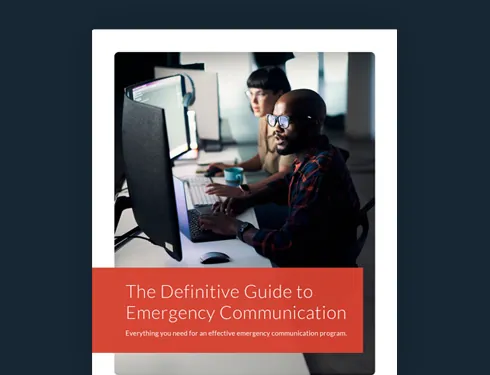
Communication Strategies To Effectively Navigate a Crisis [Webinar Recap]
It is almost a sure bet that your organization will have a crisis on its hands at one time or another. Check out the recap of our recent webinar where we review ways to prepare for them.

In 2018, the residents of the U.S. State of Hawaii received a message through the Emergency Alert System warning them of an impending ballistic missile strike. For 38 minutes after the alert was sent, residents of Hawaii began to panic and scramble for hard cover. Then, a second message came through. The first one was a mistake, a false alarm, and everything was actually fine.
The commotion and confusion around the messages prompted an investigation into how such an error could have occurred. It found simple mistakes in messaging and planning that led to the error that shook the island state, and multiple officials at Hawaii Emergency Management Agency resigned over the incident.
With cases like these, it’s easy to see how communication strategies can make or break an organization’s ability to respond to a crisis. AlertMedia hosted a webinar on this exact issue with guest Jeff Hahn. Stick with us to read the highlights.
Jeff has over 30 years of experience in crisis communications, and he is the author of Breaking Bad News: 12 Essential Crisis Communication Tools, insights from which he used throughout his presentation. Joining him was Peter Steinfeld, Senior Vice President of Safety Solutions here at AlertMedia.
The Definitive Guide to Emergency Communication
The Importance of an Effective Communication Strategy
Jeff began by sharing a powerful personal story. When he was just ten years old, a tornado ripped through his family farm, taking the barn, 4 grain silos, and 70 heads of cattle with it. That experience motivated Jeff to pursue a career in crisis management, and we’re glad he was able to share his wealth of knowledge with our guests and us.
According to Jeff, experiencing a crisis isn’t a matter of if. It’s a matter of when. Regardless of your profession, industry, or location, if your organization is around long enough, it will have a crisis on its hands at some point. So, once we accept that we can’t eliminate crises, we have to plan for them.
How To Control the Narrative During a Crisis
One of the most important things to do in an emergency is to make sure that you control the narrative. Make sure that you take charge of the situation and your people with the following tips:
Assemble a rapid response team
A rapid response team is a group of people who are charged with various responsibilities so that your organization can react immediately to a crisis. Unfortunately, assembling and activating this team is one of the most common issues Jeff sees among companies, but good planning can avoid that. Jeff walked us through the constituent roles of a good rapid response team.
- Chief Decision Maker: essentially the CEO of the response team. This role does not need to be the leader of the company, but it does need to be someone who can take in and synthesize information quickly and reliably for their team.
- Deputy Decision Maker: This person is meant to act as a backup in case the Chief Decision Maker is unavailable.
- Rapid Response Team Coordinator: These members are usually excellent administrators and communicators and essentially become the “project managers” of crisis response. They need to be organized and make sure everyone is in step.
- Senior Communication Leader: They anticipate the needs and concerns of the company’s stakeholders and determine what they need to know to stay safe.
- Communication Manager: This is a front-line role that works with the Senior Communication Leader to put ideas into actual messages and deliver them to the right people.
- Subject Matter Experts: These are experts on the technical side of the situation, and these people will likely be different depending on what crisis is at hand.
- Legal Counsel: This is a lawyer who is there to consider the legal implications of the response team’s actions, as well as remind them of their duty of care.
The 5 foundational components of a crisis communication plan
Now that you have your team together, you need a plan to execute. you can break this plan down into five parts:
- Principles
- Define the values and general goals of the organization when it comes to crises. For example, valuing speed in communication will emphasize creating a clear communication protocol ahead of time, so that when an incident does rear its head, the team is prepared to coordinate quickly.
- Define the values and general goals of the organization when it comes to crises. For example, valuing speed in communication will emphasize creating a clear communication protocol ahead of time, so that when an incident does rear its head, the team is prepared to coordinate quickly.
- Activation
- This is the nitty-gritty of getting the team ready to act. Make sure people know their responsibilities, what resources they need, and with whom they need to connect.
- Incident Inventory
- It can be overwhelming trying to prepare for every possible incident, but Jeff suggested breaking it down into three buckets:
- Reputation issues for the brand
- Safety issues
- Emergency issues
- It also helps to rank these in terms of severity and likelihood.
- It can be overwhelming trying to prepare for every possible incident, but Jeff suggested breaking it down into three buckets:
- Preset Messaging
- What would you say if a crisis happened? What would your people need to hear? Don’t get too specific here, as the crisis you encounter might not be exactly the one you imagined.
- Channel and Inventory Passwords
- Compile all essential assets, and ensure those who need access to specific tools have them. Your recovery efforts can be seriously hampered if certain people can’t access particular systems, software, or equipment.
Jeff then answered questions that he frequently hears from the companies he works with.
Frequently Asked Questions
How do we avoid common roadblocks?
Jeff brought up three common problems and ways to fix them.
- Assembly is a common pain point, but simple procedure and practice make perfect. Each rapid response team member’s assembly instructions should be concise and straightforward enough to fit on a business card.
- Learn from past mistakes as these are often the most valuable learning experiences for a brand because they know exactly how poor planning and execution impacted them.
- Try to control the conversation, but don’t be surprised when employees post about a crisis on social media. There is no “getting ahead” of that, according to Jeff. Instead, rapid response teams can create digital “newsrooms” or event pages where people can go to get the latest information. This makes it less likely that your employees spread misinformation or panic.
How is a crisis communications plan different from a business continuity plan?
The difference between these two is subtle, but Jeff summed it up neatly. Simply put, crisis plans are supposed to solve issues that are unexpected, while business continuity instead focuses on specific eventualities that can be foreseen and planned for, many of which are non-crises and often focus on supply chain issues or other logistical events.
What’s the best approach to notifying employees when the company experiences a crisis?
If you have the time and the ability, talk to people on-site or near the incident quickly. They are more likely to be at risk and will become unsettled if not properly communicated with. Prioritize proximity in your communications.
Then, you should expand the scope of your message over the phone and the internet to people not immediately affected or nearby.
Key Takeaways
Jeff left us a few tips summarizing the key lessons he wanted to leave us with.
- There is no “fixer” in a crisis. That is, no singular person is solely responsible for fixing a problem. Don’t expect an emergency to clear up after one phone call or email. Instead, focus on protocol and process, and your people will see your organization through.
- Options are better than answers. There is no one-size-fits-all approach when it comes to a crisis. Instead, have multiple choices of actions to take, and let your rapid response team choose the best one for the specific situation.
- Pressurized environments are the worst situations to make complicated decisions. A crisis is chaotic and stressful enough. If you don’t plan appropriately ahead of time, you won’t respond quickly and correctly in an emergency, putting your people and business at risk.



![6 Steps to Creating an Effective Emergency Response Plan [+ Template]](https://www.alertmedia.com/wp-content/uploads/2023/10/Blog-Emergency-Response-Plan.webp)
